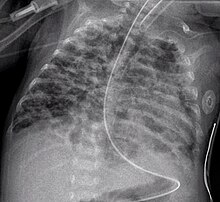User:Mr. Ibrahem/Bronchopulmonary dysplasia
| Bronchopulmonary dysplasia | |
|---|---|
 | |
| An X-ray showing bronchopulmonary dysplasia. Person is also intubated and has an oral gastric tube. | |
| Specialty | Pediatrics |
| Symptoms | Increased work of breathing[1] |
| Complications | Trouble feeding, GERD, pulmonary hypertension, delayed speech, heart problems, asthma, infections[2][3] |
| Usual onset | Newborn[3] |
| Duration | Long term[3] |
| Risk factors | Prematurity, prolonged mechanical ventilation or supplemental oxygen, sepsis, chorioamnionitis before birth, mother who smokes[2][3] |
| Diagnostic method | Based on needing respiratory support[2] |
| Prevention | Corticosteroids before birth, surfactant, caffeine, lowest possible supplemental oxygen[3] |
| Treatment | Oxygen therapy, continuous positive airway pressure (CPAP), bronchodilators, diuretics[2] |
| Prognosis | Often improve over few months[2] |
| Frequency | Relatively common[1] |
Bronchopulmonary dysplasia (BPD) is a lung disease in which babies need breathing support 28 days after birth or around the time they would have reached their original due date.[2] Symptoms include increased work of breathing, in the absence of other conditions.[1][3] Complications may include trouble feeding, GERD, pulmonary hypertension, delayed speech, heart problems like patent ductus arteriosus, asthma, and infections.[2][3]
The primary risk factors are prematurity, prolonged mechanical ventilation or supplemental oxygen, sepsis, and chorioamnionitis before birth.[2][3] Other risk factors include a mother who smokes.[3] The underlying mechanism involves incompletely or abnormally developed and fragile lungs.[2] It is a type of newborn breathing condition along with respiratory distress syndrome and meconium aspiration syndrome.[4]
Treatment may involve nutrition, oxygen therapy, continuous positive airway pressure (CPAP), bronchodilators, diuretics, and caffeine.[2][3] An antibody against respiratory syncytial virus (RSV) may also be given.[3] Prevention may include the use of surfactant replacement therapy and corticosteroids before birth.<re name=Mer2022/> Most of those affected gradually improve over two to four months.[2] Some may experience permanent breathing difficulties while other may die as a result.[2][3]
Bronchopulmonary dysplasia is relatively common.[1] About half of those with a birth weight of less than 1,500 grams are affected.[1] Males are more commonly affected than females.[3] The condition was first named in 1967.[1]
References[edit]
- ^ a b c d e f Sahni, M; Mowes, AK (January 2022). "Bronchopulmonary Dysplasia". PMID 30969701.
{{cite journal}}: Cite journal requires|journal=(help) - ^ a b c d e f g h i j k l "Newborn Breathing Conditions - Bronchopulmonary Dysplasia (BPD) | NHLBI, NIH". www.nhlbi.nih.gov. Archived from the original on 9 May 2022. Retrieved 20 June 2022.
- ^ a b c d e f g h i j k l m "Bronchopulmonary Dysplasia (BPD) - Pediatrics". Merck Manuals Professional Edition. Archived from the original on 20 June 2022. Retrieved 20 June 2022.
- ^ "Newborn Breathing Conditions - What Are Newborn Breathing Conditions? | NHLBI, NIH". www.nhlbi.nih.gov. Archived from the original on 20 June 2022. Retrieved 20 June 2022.
